Physical Address
304 North Cardinal St.
Dorchester Center, MA 02124
![Utilization of gross evaluation, advanced imaging modalities, and histological evaluation to provide a comprehensive approach to medical device pathology [1] . Utilization of gross evaluation, advanced imaging modalities, and histological evaluation to provide a comprehensive approach to medical device pathology [1] .](https://storage.googleapis.com/dl.dentistrykey.com/clinical/Thepathologyofcardiovascularinterventionsanddevicesforcoronaryarterydiseasevasculardiseaseheartfailureandarrhythmias/0_3s20B9780128222249000244.jpg)
The last several decades have witnessed a virtual explosion in the armamentarium of interventional and surgical procedures and medical devices available to manage cardiovascular diseases. For example, percutaneous treatment of coronary artery disease is one of the most widely done medical procedures, with greater than one million procedures performed worldwide each year . In total, over five million vascular and cardiac surgeries and procedures are performed each year in the United States alone . To a large extent, the use of these techniques and the associated implanted medical devices that enable them has created pathologic features that were not previously encountered. The pathologist fulfills an important function in documenting these pathological changes . In the third edition of Cardiovascular Pathology , Schoen and Edwards provided a detailed analysis of the morphological, pathobiological, and clinical considerations pertinent to the most important and widely used procedures and devices . This chapter updates and extends the information on pertinent procedures and devices and relates the findings to other chapters that address the pathological processes requiring intervention and the pathological considerations in the evaluation of the outcome of procedures and device implantation.
The pathobiology of myocardial ischemic injury progressing to acute myocardial infarction (MI) and its complications is well established (see Chapter 10 : Myocardial Ischemia and Its Complications) . Owing to the progressive nature of the tissue damage that occurs in the evolution of acute MI (see Chapter 10 : Myocardial Ischemia and Its Complications), timely reperfusion of jeopardized myocardium is the most effective means of restoring the balance between myocardial oxygen demand and supply, thereby alleviating ischemia and salvaging muscle. This provides the rationale for percutaneous coronary intervention (PCI) and was first achieved by the institution of thrombolytic therapy . The benefits of thrombolysis are now well established; revascularization by thrombolysis and more recently other techniques of PCI in early acute MI limit infarct size, preserve left ventricular function, and improve survival . Detailed guidelines are now available for the use of PCI in the management of patients with stable ischemic heart disease and evolving MI .
Early intravenous or intracoronary therapy using thrombolytic drugs yields an overall reduction in mortality, the degree of which is largely determined by the time interval between the onset of symptoms and a successful intervention, the adequacy of early coronary reflow, and the degree of residual stenosis of the infarct vessel . For both survival and improvement in left ventricular function, the greatest benefit accrues when the agents are administered as early as possible, particularly when this occurs less than 1–2 h after symptoms begin . The reduction in mortality can be dramatic; in one study, effective thrombolysis of the infarct-related artery within 90 min reduced 30-day mortality from 9% to 4% and enhanced parameters of left ventricular contraction . Using the thrombolytic agents streptokinase, urokinase, or tissue-derived plasminogen activator, recanalization rates vary from 60% to 90% . Despite reocclusion rates of the infarct-related artery as high as 10% in-hospital (corresponding to 5% reinfarction), half between the first and the second week , and 30% in 3 months, the short-term survival benefit of thrombolytic therapy is maintained long-term. Today, primary thrombolytic therapy has largely been supplanted by catheter-based interventional techniques, as described below.
Catheter-based interventional techniques, known as PCI, of which percutaneous transluminal coronary angioplasty (PTCA) is the prototype, represent a major therapeutic advance in the management of coronary artery disease. PTCA is widely used in patients with stable angina, unstable angina, or acute MI . According to the American Heart Association, over 400,000 of these procedures are presently done annually in the United States, at an average cost of ~$20,000 . The success rate for PTCA is greater than 90% with a complication rate of less than 5% and a failure rate less than 10% .
The mechanisms of luminal expansion in coronary balloon angioplasty and its consequences have been characterized in animal models, postmortem human hearts, specimens obtained from patients who have undergone PTCA, and by in vivo intravascular ultrasound. The five possible mechanisms of luminal expansion are (1) plaque fracture, (2) medial dissection, (3) stretching of plaque-free arterial segments, (4) plaque stretching, and (5) plaque compression and redistribution ( Figs. 18.1 and 18.2 and Table 18.1 ) .
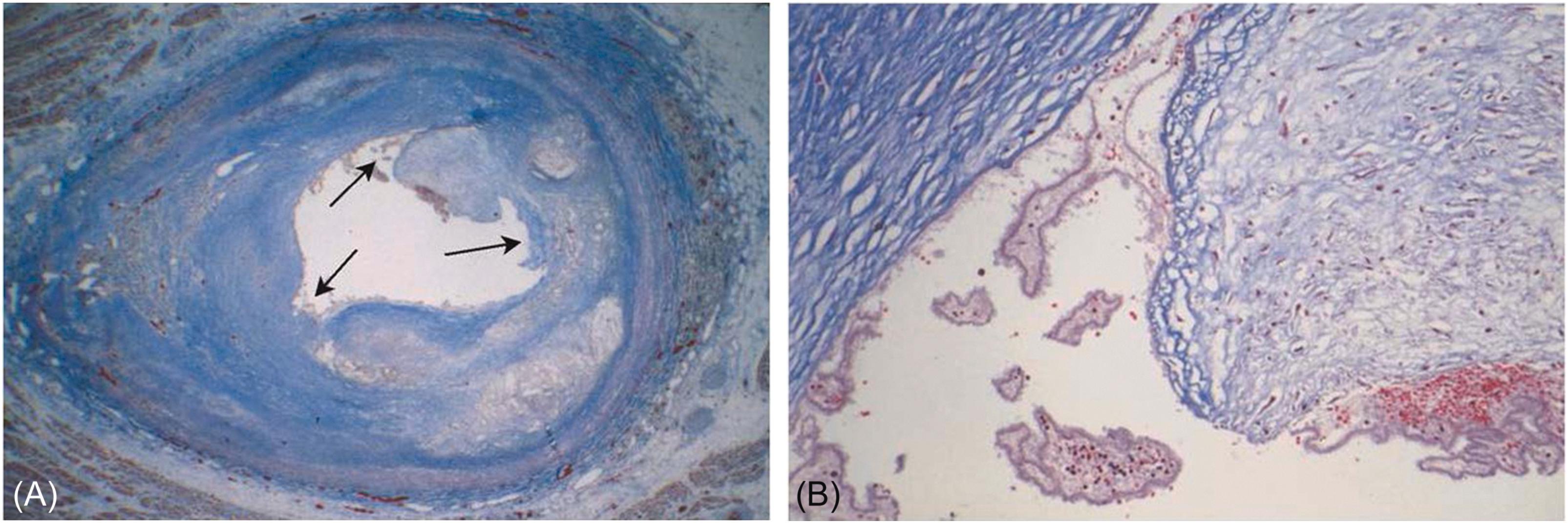
![Figure 18.2, Plaque fracture encompassing intima and media ( arrow ) and partial circumferential wall dissection induced by percutaneous coronary balloon angioplasty (PTCA). These features account for both the efficacy and potential complications of PTCA (Elastin stain) [20, p. 75] . Figure 18.2, Plaque fracture encompassing intima and media ( arrow ) and partial circumferential wall dissection induced by percutaneous coronary balloon angioplasty (PTCA). These features account for both the efficacy and potential complications of PTCA (Elastin stain) [20, p. 75] .](https://storage.googleapis.com/dl.dentistrykey.com/clinical/Thepathologyofcardiovascularinterventionsanddevicesforcoronaryarterydiseasevasculardiseaseheartfailureandarrhythmias/2_3s20B9780128222249000244.jpg)
| Mechanism | Clinicopathologic correlation |
|---|---|
| Fracture of plaque | Major mechanism of expansion of lumen in complicated atherosclerotic plaque |
| Dissection into the media | Usually accompanies plaque fracture |
| Stretching of plaque-free segments | Largely reversible effect |
| Stretching of plaque | Most likely in eccentric lesions; minimal and largely reversible effect |
| Compression and redistribution of plaque | Does not usually account for significant long-term expansion of lumen |
In PTCA, the progressive and substantial expansile force induced by a balloon inflated at 8–12 atm of pressure causes a radial force that induces an acute and complex arterial injury consisting of endothelial denudation, plaque fracture, intimal-medial separation accompanied by an intramural dissection, and stretching of the media and adventitia, which causes the essentially nondistensible plaque to split . The site of plaque disruption (its weakest point) is not necessarily that which is most severely involved with atherosclerosis. The split extends at least to the intimal-medial border and often into the media, with consequent circumferential and longitudinal dissection . Dissimilar plaques respond differently to balloon dilation, and the composition and configuration of the original atherosclerotic lesion play a key role in the outcome of angioplasty . Immediate success is probably enhanced in arteries having eccentric plaques with large lipid-rich necrotic cores and/or calcification, in contrast to concentric fibrotic lesions. For eccentric atheromas, balloon-induced splits most commonly involve the junction between the plaque and the disease-free portion of the arterial wall.
Plaque fracture, medial dissection, and stretching of the media beyond the dissection are accompanied by local flow abnormalities and generation of new thrombogenic blood-contacting surfaces ( Figs. 18.3 and 18.4 ). This supports the concept that an atherosclerotic plaque after angioplasty has many features of a spontaneously disrupted plaque, namely those associated with the acute coronary syndromes. The immediate postangioplasty healing process in either arteries or bypass grafts is not well understood, but dissolution of soft atheromatous material, retraction of the split plaque, thrombus formation, and intimal healing with re-endothelialization likely contribute.
![Figure 18.3, Acute thrombotic occlusion of localized atherosclerotic coronary stenosis following PTCA with extensive dissection extending both proximal and distal to plaque fracture of lesion ( arrows ), including and likely compressing a minimally stenotic distal vessel segment ( arrowhead ) [20, p. 77] . Figure 18.3, Acute thrombotic occlusion of localized atherosclerotic coronary stenosis following PTCA with extensive dissection extending both proximal and distal to plaque fracture of lesion ( arrows ), including and likely compressing a minimally stenotic distal vessel segment ( arrowhead ) [20, p. 77] .](https://storage.googleapis.com/dl.dentistrykey.com/clinical/Thepathologyofcardiovascularinterventionsanddevicesforcoronaryarterydiseasevasculardiseaseheartfailureandarrhythmias/3_3s20B9780128222249000244.jpg)
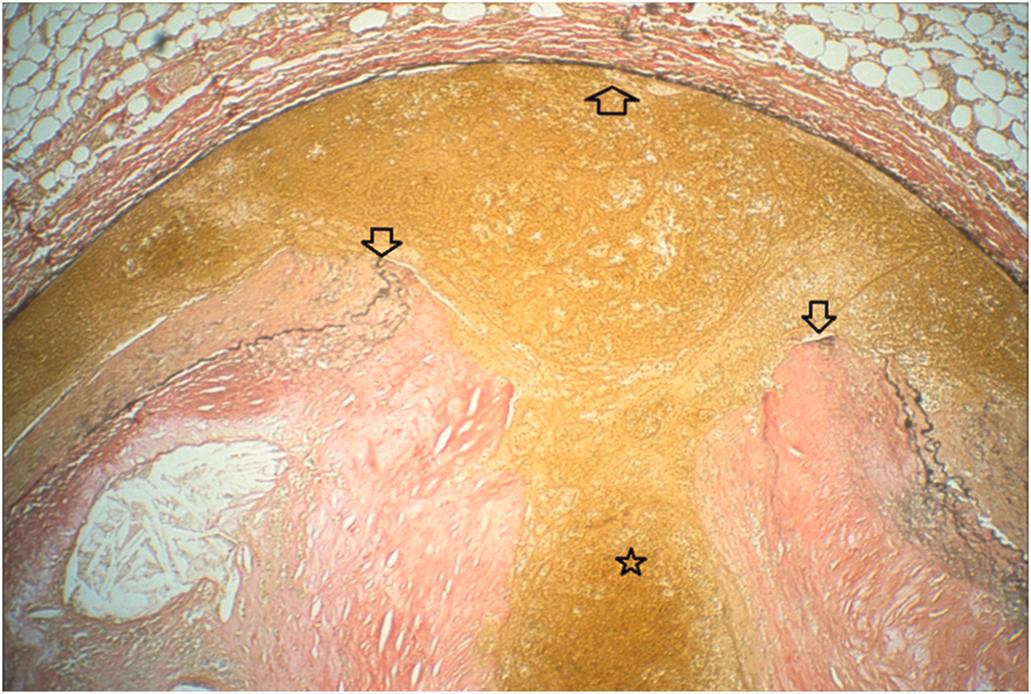
PTCA has largely replaced primary thrombolytic therapy for the treatment of acute MI in patients reaching the hospital . Primary PTCA is beneficial in reducing the composite end point of death, recurrent MI, or stroke, but this benefit is attenuated at 6 months (owing to proliferative restenosis; see below). Thus primary PTCA may ultimately achieve a higher patency rate, but thrombolytic therapy may actually open more arteries very early (before 60 min). However, the risk for early reocclusion is nearly twofold higher for patients receiving thrombolysis than for patients receiving primary PTCA. Today, low-dose thrombolytic therapy is being used as initial therapy in the field while patients are being transported to the hospital where PCI is instituted . Ongoing research is aimed at developing adjunctive therapy to reduce the amount of reperfusion injury that frequently develops with either thrombolytic therapy or PCI .
Major ischemic complications of PTCA that prompt emergency bypass surgery occur in less than 1% of patients treated by PTCA . Features associated with increased risk for PTCA complications include advanced age, female gender, congestive heart failure (HF) or left ventricular dysfunction, recent thrombolytic therapy, and complex coronary lesional anatomy. Periprocedural MI owing to side branch occlusion or embolization of thrombus, platelet aggregates, or plaque occurs in 5%–20% of patients. The most important complications are abrupt closure (i.e., an early and sustained reduction of flow in the treated vessel) and restenosis (i.e., late loss of the acute luminal gain at the treated site) .
The incidence of abrupt closure after PTCA ranges from 4% to 9%, depending on precise definition of this complication as well as patient risk factors, including unstable angina, diabetes, and chronic hemodialysis and target lesions that are long, angulated, calcified, or markedly (>80%) stenotic . The mechanisms of abrupt closure and therapeutic luminal expansion are related. For example, a dissection that involves a considerable portion of the circumference can generate a “flap” that may impinge on the lumen. Alternatively, a dissection that involves a substantial proximal-to-distal segment of the vessel, and which traverses a large plaque-free wall segment, can induce compression of the vessel at a point of minimal disease ( Fig. 18.3 ). Exposure of subendothelial vascular wall components, especially with the stasis engendered by medial flaps, induces platelet deposition and activation with thrombin formation, which can lead to obstructive thrombus ( Fig. 18.4 ). In a small number of patients, reduction in distal flow occurs without evidence of dissection or distal embolization. It is reversible with vasodilators, suggesting microvascular spasm as the cause.
Progressive restenosis accompanied by recurrent ischemic signs and symptoms limits the long-term success of angioplasty ( Fig. 18.5 ). Clinically significant restenosis occurs in ~30%–50% of patients after coronary balloon angioplasty, most frequently within the first 4–6 months. Restenosis probably represents a fundamental but complex vascular healing response that achieves clinical significance only in some patients. The risk of restenosis depends on definition used, patient population, and lesion complexity. For example, the long-term outcome is better among patients with single-vessel disease than those with multivessel disease. Many therapeutic approaches have been directed toward prevention of restenosis. Endovascular stents have reduced the frequency of this complication (see later). PTCA has also been used in coronary bypass grafts, but the late success rates are less than in native vessels.
![Figure 18.5, Restenosis after balloon angioplasty. (A) ( Left panel ) Gross photograph, demonstrating residual atherosclerotic plaque ( arrowhead ) and a new, glistening proliferative lesion ( arrow ). (B and C) Proliferative tissue causing occlusive restenosis several months after coronary balloon angioplasty and obtained by atherectomy. (B) ( Middle panel ) General morphology of the stellate mesenchymal cells haphazardly arranged in abundant loose myxoid matrix. (C) ( Right panel ) Positive immunoperoxidase staining for α-smooth muscle cell actin demonstrating that these cells possess a smooth muscle cell phenotype [(B) H&E stain; (C) immunoperoxidase stain]. Figure 18.5, Restenosis after balloon angioplasty. (A) ( Left panel ) Gross photograph, demonstrating residual atherosclerotic plaque ( arrowhead ) and a new, glistening proliferative lesion ( arrow ). (B and C) Proliferative tissue causing occlusive restenosis several months after coronary balloon angioplasty and obtained by atherectomy. (B) ( Middle panel ) General morphology of the stellate mesenchymal cells haphazardly arranged in abundant loose myxoid matrix. (C) ( Right panel ) Positive immunoperoxidase staining for α-smooth muscle cell actin demonstrating that these cells possess a smooth muscle cell phenotype [(B) H&E stain; (C) immunoperoxidase stain].](https://storage.googleapis.com/dl.dentistrykey.com/clinical/Thepathologyofcardiovascularinterventionsanddevicesforcoronaryarterydiseasevasculardiseaseheartfailureandarrhythmias/5_3s20B9780128222249000244.jpg)
Although vessel wall recoil and organization of thrombus likely contribute, the major process leading to restenosis is excessive smooth muscle proliferation as a response to angioplasty-induced injury ( Fig. 18.5 ). Medial smooth muscle cells migrate to the intima where, along with existing plaque smooth muscle cells, they proliferate and secrete abundant extracellular matrix, consisting predominantly of collagen and glycosaminoglycans . This yields lesions that have a loose myxoid matrix in which numerous stellate smooth muscle cells are haphazardly arranged. Over time, the extracellular matrix becomes more densely collagenous, and the neointima becomes less cellular, with scattered spindle-shaped cells in a more laminar arrangement. The process of restenosis has mechanistic similarities to both atherosclerosis and vascular graft healing. Moreover, after prominent thrombus formation, or in a hyperlipidemic patient, the site of healing may also contain foam cells and lipid crystals, resembling a mature fibrofatty atheroma. There is considerable interest in locally delivered pharmacologic and molecular therapies to mitigate restenosis. However, despite the efficacy of various approaches in animal models, success in humans has not been effective. In general, the largest acute luminal diameter provides better tolerance of subsequent intimal proliferation before hemodynamically significant renarrowing results at the treatment site.
In contrast to angioplasty, which effects a redistribution of atherosclerotic plaque constituents, atherectomy procedures, such as directional or rotational atherectomy, remove obstructive atherosclerotic tissue by excision or ablation . The morphology of arterial vessel healing after transluminal plaque removal is similar to that after angioplasty, but the rate of vascular complications is higher. Although restenosis is a limitation of directional atherectomy, atherectomy techniques may permit a larger acute lumen than angioplasty, with potential benefits. However, excisions deeper than an angiographically “normal” arterial lumen may occur. Beyond therapeutic objectives, directional atherectomy obtains human tissue that may be used to investigate vascular pathobiology, including the mechanisms of restenosis and the effects of various pharmacologic or mechanical therapies or plaque ablation procedures.
Metallic balloon-expandable and self-expanding intravascular stents were developed to reduce or eliminate the untoward effects of PTCA, which include thrombosis and restenosis, largely owing to endothelial injury and subsequent smooth muscle cell proliferation and extracellular matric production . Intravascular stents can provide a larger and more regular lumen, initially acting as a scaffold to support the intimal flaps and dissections that occur in PTCA, limit elastic recoil, mechanically prevent vascular spasm, and increase blood flow, all of which can minimize thrombus formation and reduce the impact of postangioplasty restenosis. Endoluminal stents also provide a means of delivering any localized therapy intended to reduce restenosis, such as a pharmacologic agent or radiation.
Stents are flexible endovascular prostheses usually fabricated from stainless steel or other metal alloys, or plastic, and designed as either coils or slotted tubes. Deployment involves peripheral vascular access, threading through the arterial tree to a site of obstruction, followed by expansion of the stent circumferentially in apposition to the inside surface of the coronary artery in order to increase the size of the lumen. Stents are either expandable by a balloon or self-expanding. The stent is mounted on a balloon catheter and, with the aid of fluoroscopic screening and radiopaque markers, the stent is positioned across a stenotic lesion, which has usually been predilated with a balloon ( Figs. 18.6 and 18.7 ). Self-expanding stents are fabricated from nitinol, an alloy of nickel and titanium that has “shape memory” characteristics (i.e., the stent is compressed into the delivering catheter at room temperature, and then spontaneously recovers its original, undeformed, expanded stent shape upon removal of the delivery sheath and heating to body temperature); they do not require balloon expansion. Available stents range from 2.5 to 6 mm in diameter and from 8 to 50 mm in length.
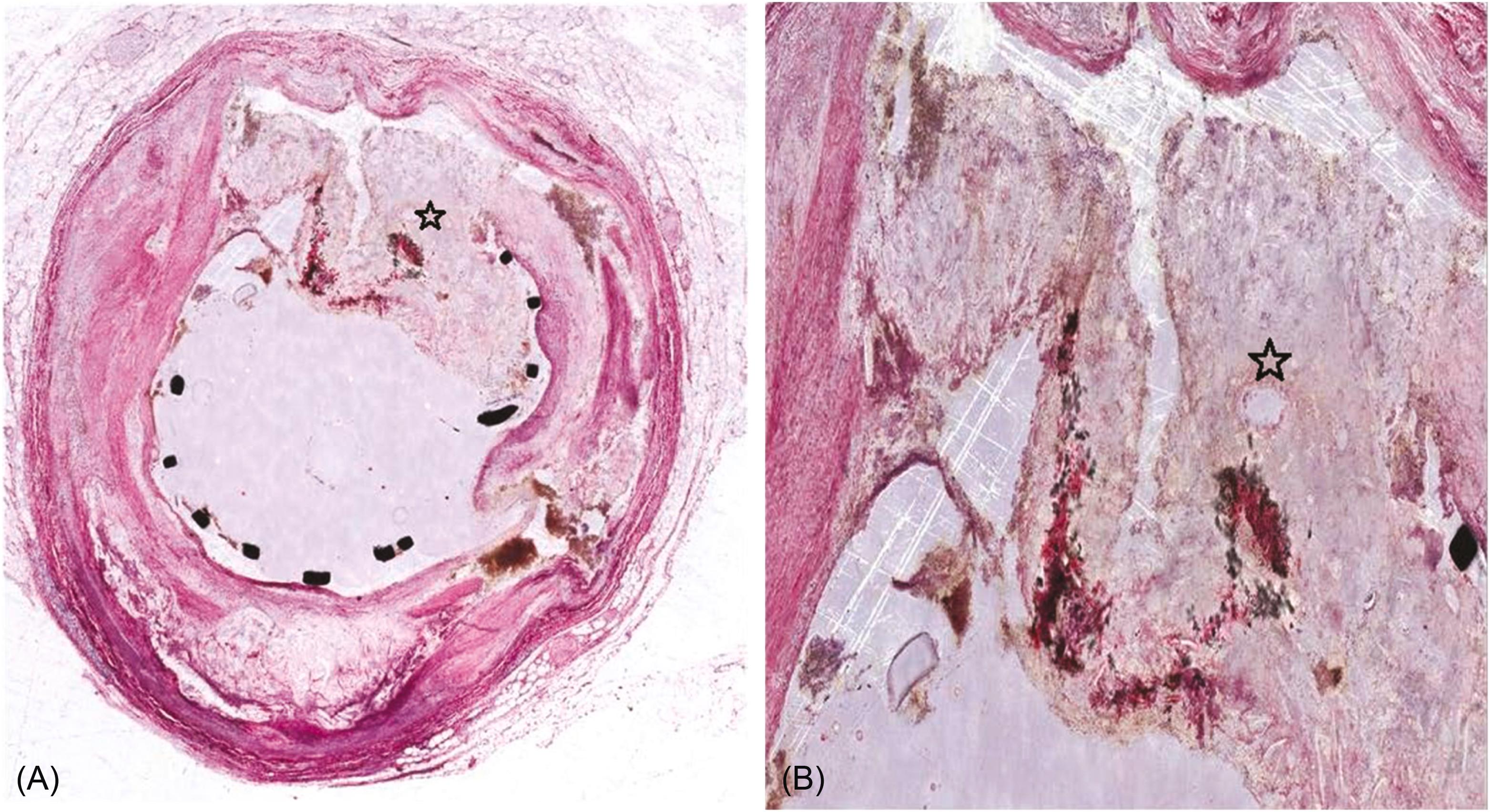
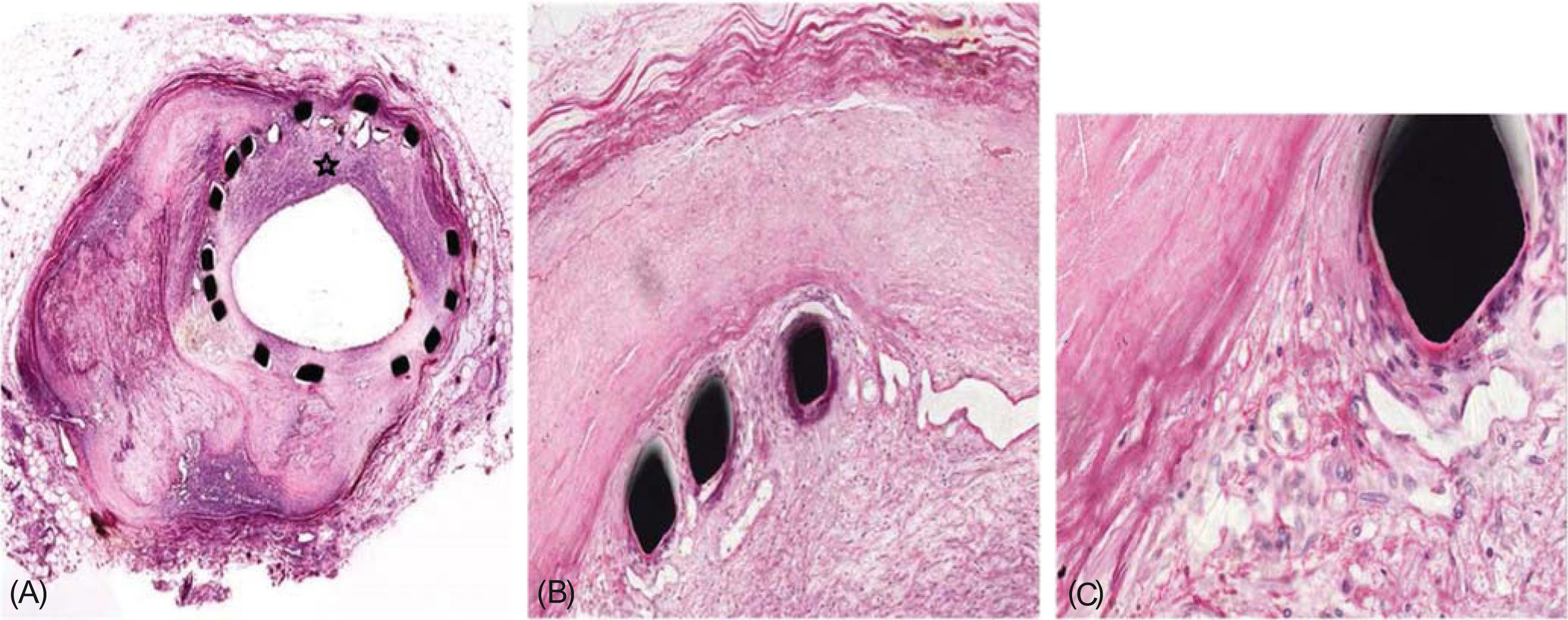
Initial prospective randomized controlled trials (RCTs) comparing conventional PTCA with stent implantation in patients with stable and unstable angina who had a single, de novo, focal stenosis in a large (>3 mm diameter) native coronary artery demonstrated clinical benefit to stenting . Subsequently, implantation of multiple stents in patients with multivessel coronary artery disease and stents in diseased bypass grafts has become feasible.
The first coronary stents developed for clinical use were bare-metal stents (BMS). The proliferative restenosis that occurs after PTCA alone was found not to be prevented by stenting with BMS, and the tissue between the stent and the blood (called a neointima ) may progressively thicken. With the goal of eliminating this intimal thickening, drug-eluting stents (DESs) were developed . DESs markedly reduced restenosis compared with BMS, and consequently, they have been widely used in the treatment of coronary artery disease. The first generation of DES, composed of stents coated with a polymer containing either of the drugs, sirolimus or paclitaxel, had significant problems, including hypersensitivity reactions, delayed healing, and restenosis, often with superimposed atherosclerosis . More recently, stenting has progressed to second-generation drug-eluting metal stents, with features intended to improve implantation and biocompatibility, such as thinner struts, improved designs that maintain radial strength, despite improved deployability, biodegradable drug-containing polymers, and new drugs and dosing regimens. Notwithstanding these improvements, rigid metallic stents (BMS and DES) inhibit coronary vasomotion owing to splinting, interfere with further interventions such as coronary artery bypass grafting, and can cause prolonged tissue reactions.
Therefore there is considerable interest in developing drug-eluting biodegradable/resorbable/stents (BRSs) composed of biomaterials that degrade and disappear over time . In contrast to the permanent presence of a foreign body in BMS and DES, BRSs provide a scaffold to support vessel expansion, avoid restenosis, and then ultimately disappear completely by resorption of the foreign material. BRSs also ultimately permit more versatility in subsequent therapies, and do not interfere with the diagnostic evaluation by noninvasive imaging such as cardiac magnetic resonance and CT. The most studied BRS is the Absorb bioresorbable vascular scaffold (Absorb BVS, Abbott Vascular). However, conflicting data regarding the safety and efficacy of RBS and efficacy in preclinical and clinical studies, particularly related to the possibility of stent thrombosis, have slowed down their introduction into the market .
The complications and limitations of stenting with either BMS or DES include initial failure, early thrombosis, and late restenosis ( Fig. 18.8 ). Subacute stent thrombosis (ST) occurs in 1%–3% of patients, usually within 7–10 days of the procedure, and results in occlusion of the stented vessel with platelet-rich thrombus and associated MI or death. Antiplatelet treatment minimizes the risk of subacute ST. With BMS, the most significant complication associated with long-term stent placement is in-stent restenosis caused by intimal thickening . DESs greatly reduce the risk of restenosis due to intimal proliferation compared with BMS; however, late ST emerged as a major safety concern with first-generation DES early after their adoption in clinical practice, requiring prolonged dual antiplatelet therapy . Biomarkers are being utilized to predict complications of stent placement .
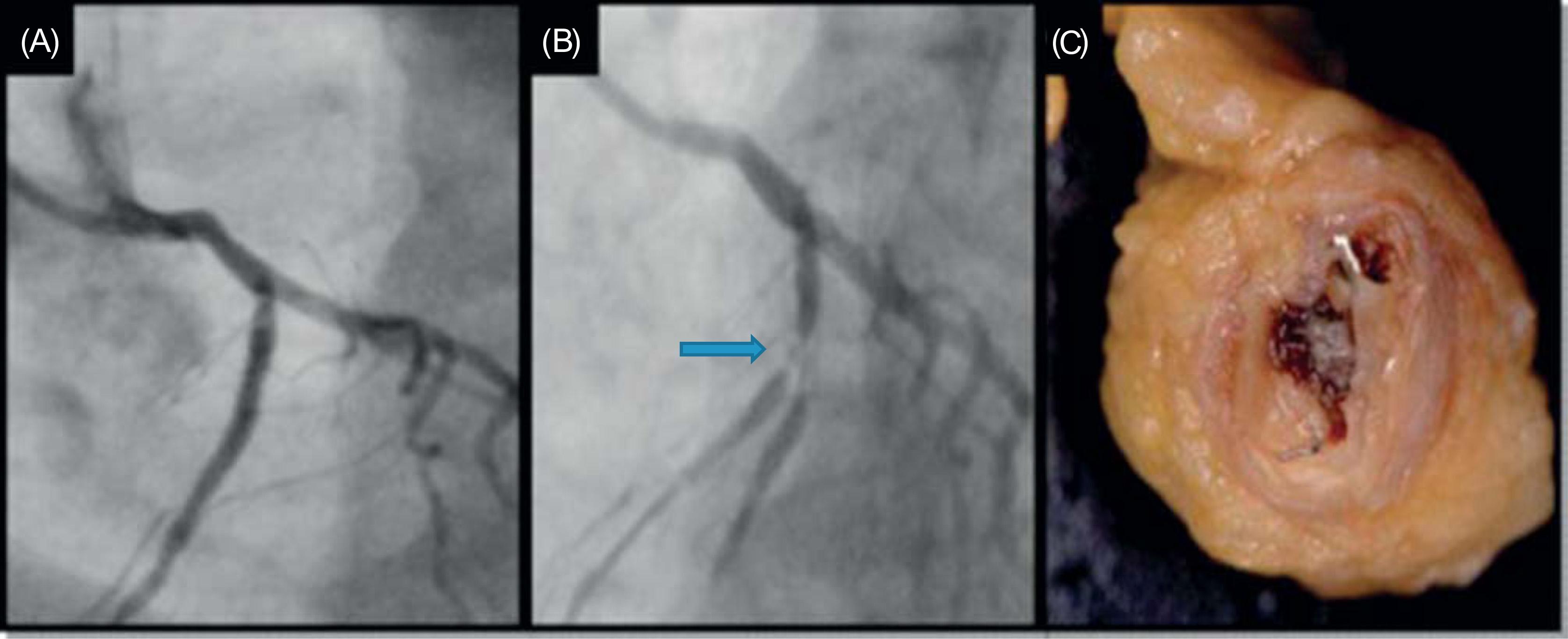
The histologic changes induced in human atherosclerotic coronary arteries by a wide variety of commercial stents have been described . In general, implantation is accompanied by damage to the endothelial lining and stretching of the vessel wall, stimulating early adherence and accumulation of platelets and leukocytes . Stent wires are initially covered with a variable platelet-fibrin coating. They may eventually become completely covered by a neointima, whereby the wires are embedded in a layer of intimal thickening consisting of α-actin positive smooth muscle cells in a collagenous matrix, in some cases with foam cells, extracellular lipid, and lipid crystals predominantly near the stent wires ( Fig. 18.8 ). Ultimately, there is a neointima lined by endothelium. Most stent struts are in direct contact with atherosclerotic plaque; in some cases, medial damage is associated with struts.
One study reported findings in 55 stents at a mean of 39 days after implantation, and in 10 patients later than 30 days . Fibrin, platelets, and neutrophils were associated with stent struts early after deployment. In stents implanted 3 days or less, inflammatory cells were sparse when associated with struts in contact with fibrous plaque but were prominent with struts embedded in either lipid core or damaged media. Neointimal growth in stents implanted longer than 30 days was greatest at strut sites when medial laceration or rupture was present compared with struts in contact with plaque or with an intact media. Medial destruction and lipid core penetration increased inflammation, and neointimal growth increased as the ratio of stent area to reference lumen area increased. The presence of increased inflammation associated with stent struts in the vicinity of damaged media and increased neointimal thickness at struts associated with medial damage suggests that deployment strategies that reduce severe arterial injury during catheter-based interventions with stents can have a beneficial effect by lowering the frequency of in-stent restenosis. An autopsy study of DES suggested that although DES reduced intimal proliferation, they impaired endothelial healing, suggesting a potential mechanism for late thrombosis . The intimal lesions that do develop in some stents may undergo secondary atheromatous change, that is, neoatherosclerosis . Distinctive features of the various first, second, and current generation stents have been characterized . As mentioned above, early clinical use of fully bioresorbable stents suggests a high degree of thrombosis . Certainly, further understanding of mechanisms of acute and chronic vascular reactions and the role of stent biomaterials and design factors will be crucial to understand and potentially eliminate deleterious interactions of various stent types . In vivo imaging studies may be a useful adjunct to observe such interactions longitudinally.
Become a Clinical Tree membership for Full access and enjoy Unlimited articles
If you are a member. Log in here